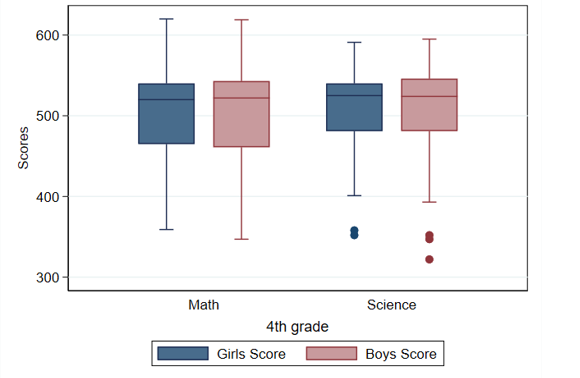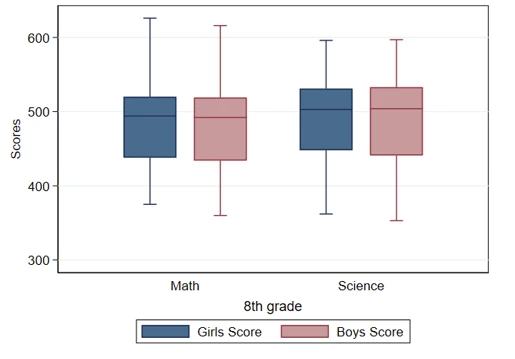The launch of the Human Capital Project has galvanized global action to close human capital gaps, and has highlighted the importance of investments in the knowledge, skills, and health that people accumulate throughout their lives, to realize their potential as productive members of society.
Improving both the quantity and quality of education is pivotal to empowering young people to fulfill their potential. Science, Technology, Engineering, and Mathematics (STEM) education is critical not only for fulfilling the needs of the future workforce, but also for producing researchers and innovators who can help to solve intractable challenges.
The underrepresentation of women and girls in STEM gets a lot of attention, but the data on access to, and quality of, education shows that the story is more nuanced.
At primary school level globally, there is gender parity in both enrollment and completion–a remarkable achievement of recent times. Gender gaps emerge in a number of low-income countries, mostly in Sub-Saharan Africa, and in some Latin American countries there are ‘reverse’ gender gaps (with boys less likely to attend or complete primary school). Overall, gender gaps (where they exist) are modest in comparison to the gaps between rich and low-income countries.
When it comes to academic performance, girls often do as well as, or better than, boys in science and mathematics.
In primary schools, there are no gender differences in science achievement in more than half of the 47 countries where performance is measured (Figure 1). Girls score higher than boys in 26 percent of the countries. The difference in achievement is almost three-times higher when girls score more than boys compared to when boys score more than girls. Results for mathematics achievement are similar. There are no gender differences in about half of the countries with data, but boys score better than girls in 37 percent of the countries.
Figure 1: Primary-school girls perform as well as boys in science and mathematics
In secondary-level education, there are lower overall rates of enrollment and completion, and larger income gaps between countries, but the overall trends are similar.
Sub-Saharan Africa has the lowest rate of completion at the lower secondary level with 43 percent while at least two-thirds of children complete this level in other regions. Sub-Saharan Africa also has the largest gender gap with 46 percent of boys completing lower secondary education compared to 41 percent of girls. The opposite is true in Latin America, where girls are 5 percentage points more likely than boys to complete lower secondary.
At secondary level, the data shows no gender differences in science achievement in about half of the countries with test scores. Girls score higher than boys in 36 percent of the countries and the difference is 2.5 times higher when girls score more than boys compared to when boys score more than girls. In mathematics girls perform as well as boys (Figure 2).
Figure 2: Secondary-school girls perform as well as boys in mathematics and science
The post-secondary level is where a stark gender gap emerges for STEM education. Globally there are more women enrolled than men in universities (112 women enrolled for every 100 men) and graduation rates for women are higher. However, Sub-Saharan Africa is an exception: As well as having very low post-secondary rates, women are less likely to be enrolled (8 percent versus 11 percent for men).
Despite higher rates of enrollment and graduation at a global level, women are less likely to major in specific STEM fields (Figure 3). Only 7 percent of women choose to study engineering, manufacturing and construction, compared to 22 percent of men. Of the students pursuing careers in information, communication and technology (ICT) fields, 28 percent are women and 72 percent are men.
The gender gap in STEM careers increases with income level (Figure 4). Women in low income countries are 9 percentage points less likely than men to enroll in programs under the category ‘engineering, manufacturing and construction’. In upper middle-income and high-income countries, the difference increases to 15 and 17 percentage points, respectively. A similar pattern but with smaller gaps is observed in ICT careers.
Paradoxically, in countries where gender gaps in human endowments and economic opportunities tend to be small, women are less likely to choose STEM professions.
Globally, women are less likely than men to enter and more likely to leave the STEM workforce. This is partly explained by the fact that fewer women than men choose to study STEM, but is also due to the composition of the labor force. Gender parity in enrollment and completion is very recent; so the current stock of female workers consists of women who went to school when girls got much less schooling. While important progress has been made, changing the profile of STEM students and workers will not happen quickly since it depends on the quantity and quality of education.
Moreover, the reasons why fewer women pursue STEM fields are complicated and are yet to be fully explained. Girls’ performance in science and math does not explain the gaps observed in post-secondary level or in the labor market. A number of reinforcing factors at the individual, community and societal level likely influence women’s low participation in STEM fields. These include individual attitudes to STEM-related subjects, along with self-efficacy, and the presence of social networks and support systems, rules, regulations, stereotypes and norms that define traditionally “feminine” or “masculine” professions.
Clearly, there is much to be done to improve women’s representation in STEM fields that have been traditionally considered male domains. Two ‘early’ interventions that can have real impact on women’s STEM participation include boosting confidence by providing girls and women with real-world experience during their studies as well as relevant role models.
Visit our Gender Data Portal to find interesting data on girls in science and technology.








Join the Conversation